#its funny because these are actually decently unique sprites
Explore tagged Tumblr posts
Text

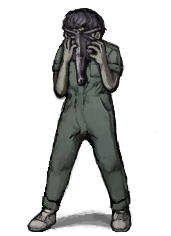

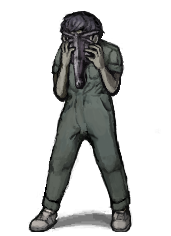
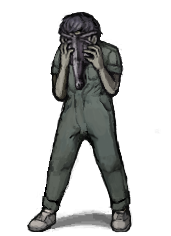
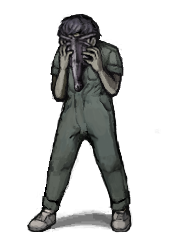



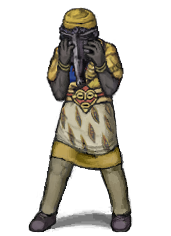
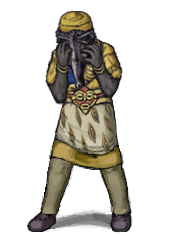
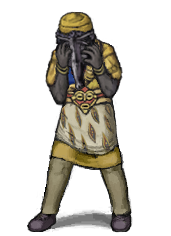
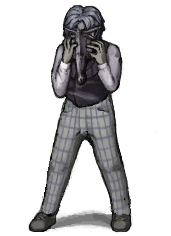
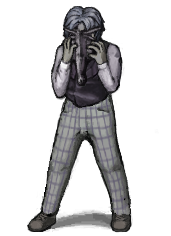
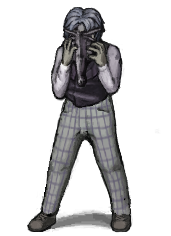


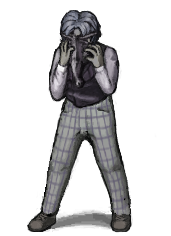
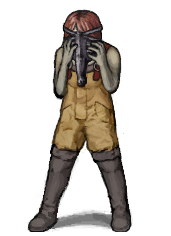
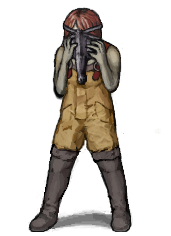
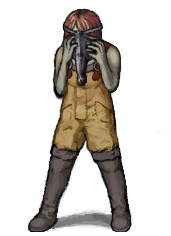
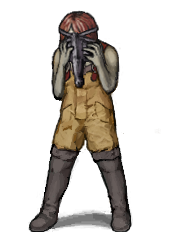
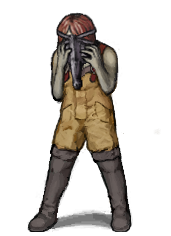
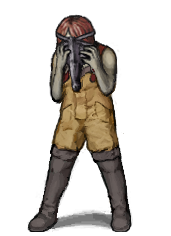
Fear and Hunger: Termina - Woodsman's Parasite Attack Animation (During Combat) (Pt.1)
#fear and hunger#funger#sprite rips#fear and hunger termina#battle sprites#for the anon who requested the parasite sprites!#its funny because these are actually decently unique sprites#in the sense that we don't see the player combat sprite from the front except during this#o'saa#levi#abella#daan#daan von dutch
70 notes
·
View notes
Text
Eternals - a disappointing mismatch of meditative character study and blockbuster film making
Just came back from watching Eternals. This was definitely a movie I was a little wary about. Eternals are not characters that I know much about from the comics. On top of that, the decidedly mixed reviews made me temper my expectations for this movie. It ended up being a good thing. Eternals is not what I would call a bad movie, but not what I would call a good one either. Its an ambitious misfire, which means that it does try to deliver a different type of superhero movie, but isn't brave enough to fully break away from convention, and as a result, the film feels like a bit of a tonal mess.
Firstly the good stuff, the film feels visual distinctive from other MCU movies. In a good way. Whereas there have been movies like Taika's Thor: Ragnorok, and Gunn's GOTG movies, which have had a visual vibrancy that is unique, this is even more distinctive. There has always been a touch of artifice in the visuals of the MCU movies. Chloe Zhao definitely goes for a far more natural look. Also, the scope and size of the film is impressive. Its a globetrotting adventure and it uses a lot of different locations in a beautiful way. The film also does a pretty decent job portraying romance and love. The relationship between Gilgamesh and Thena, between Druig and Makkari, between Sersi and Ikaris, and even the small amount we see between Sersi and Dane. Given the film is introducing 10 different characters, it is impressive that each character gets a personality that is unique and does have at least a moment or two where they stand out. Zhao handles the heavier and dramatic moments quite well.
As for what doesn't work is the pacing and the tonal inconsistencies. The film feels like its trying to do two movies worth in one film and the pacing is still somehow glacial. About 2/3 of the movie is just getting the band back together. For me, I must admit, the film suffered because I figured out the Ikaris villain twist pretty early. And I assume others must have also given the trailer basically gave it away. In the trailer we see the scene between Ikaris and Ajak, but in the movie Ajak dies fairly early in the movie. So its not a difficult deduction to make given Ikaris spends most of the movie pretending he didn't know about the Emergence. Its not a fair criticism to level against the movie, but I also feel that people who haven't seen the trailer may have also figured it out because Ikaris is a bit too stoic and inexpressive throughout the movie. Also, the deviants are kind of just pointless in the end other than to give Jolie a highlight scene in the climax. I didn't really understand how the main deviant was evolving like that and why he was targeting the Eternals. It honestly felt like the deviants were put there in order for the movie to have some action sequences littered throughout the movie. And that's another problem. The action sequences feel like an obligation rather than a natural fit in the movie. You can tell that Zhao is not comfortable with the action sequences because they are fairly dull barring the sequences with Makkari, which are pretty cool. Also, there are some weird characterizations. Like Kingo just walks out abruptly before the climax and somehow he has a devotion to Ikaris that the movie doesn't earn. Similarly Sprite spends the movie upset over Ajak's death and then sides with Ikaris even though he's responsible for her death. On top of that, she literally stabs Sersi in the back and Sersi forgives her and lets her lead a normal life. The humor, while actually quite funny from Kumail Najiani, also feels a little emotionally jarring because the rest of the film and the cast is so somber.
The performances by the cast are quite strong for the most part. Gemma Chan is quite subdued and understated in the lead role, maybe a bit too understated at times, but she does manage to deliver a powerful performance. Richard Madden is straightjacketed in a very somber and emotionless role until the last act where he comes alive. The character is unfortunately quite dull until the reveal in the last act. He does well in the end but I admit feeling a bit cold towards him throughout most of the movie. Kumail Nanjiani is quite hilarious as is Harish Patel as Karun. I kept expecting Karun to die at any moment and was surprised he made it all the way till the end. Angelina Jolie is strong in probably the most complex role, although she seems to come in and out of the movie abruptly. Don Lee gives Gilgamesh a lot of heart. Barry Keoghan as Druid is very compelling. Lauren Ridloff as Makkari gets a bit shortchanged but she is quite badass. Kit Harington is quite charming as Dane Whitman in the handful of scenes he's in. Salma Hayek seems a bit miscast and also quite wasted in the role of Ajak. She really doesn't have anything to do other than to be sagely and the role doesn't really use her trademark energy and humor. Lia McHugh as Sprite is solid. Brain Tyree Henry is strong as Phastos, though he disappears for a good chunk of the movie only to come back in the last act.
All in all, it just feels like Chloe Zhao was not quite ready for the type of film she was making. The inexperience of handling a big budget film shows. Maybe she will be all the better for it and if she makes a second Eternals movie, it will benefit from her experience in this film. Overall, it just isn't a movie that I feel will appeal to everyone. I ended up feeling a bit cold towards the movie despite liking several aspects of it. I would say it rates like a 5.5/10
#eternals#eternals spoilers#ikaris#sersi#gilgamesh#thena#kingo#phastos#makkari#druig#ajak#sprite#dane whitman#gemma chan#richard madden#kit harington#salma hayek#angelina jolie#don lee#kumail nanjiani#brian tyree henry#lauren ridloff#barry keoghan#lia mchugh#chloe zhao
19 notes
·
View notes
Text
The Master of Blasting
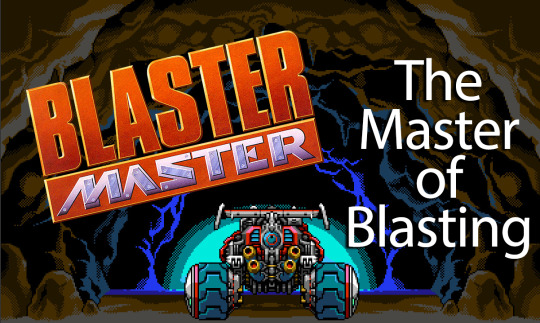
Months ago, once I realized my Retron had a save-state feature, something got into me. I realized I could go back to old retro games and actually finish them. Sure, I played 100s of games in the 8 & 16-bit eras, but I’ve never been that good at anything with a steep difficulty. Most games of the late-80s, early 90s were punishingly tough and typically, without cheat codes I never got to see the end of them.
After playing through all the old Donkey Kong Country games and Sonic the Hedgehog 1, I turned my eye towards a peculiar series I had only dabbled in before, Blaster Master. With the release of Blaster Master Zero on Switch, I was extra interested in diving into the well-regarded B-tier NES original.
With a little research, I found that a total of 8 Blaster Master games have been released...that’s when the classic Sergio completist kicked in. I convinced myself that I shouldn’t play the new Switch games until I’ve completed all of the retro titles. When I began my journey I didn’t realize it would be such a headache. Here’s my run-through of all the Blaster Master Games.
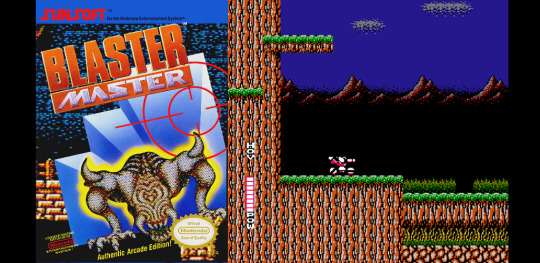
1988 - Blaster Master (NES)
Ah, the original. This little game has a charm to it that most games of the late 80′s don’t have. It was clearly inspired by Nintendo published games like Metroid and Zelda. Blaster Master’s key gimmick is the ability to play as the armored tank Sophia the 3rd or as an on-foot character named Jason, the pilot of the tank. As needed, Jason jumps out of the tank and enters human-sized doors.
Blaster Master is a 2D platformer, but once Jason enters a door, the game switches to an overhead perspective for navigation through maze-like dungeons. None of the mazes are particularly hard to solve, but all of the game’s bosses are found in these dungeons. As a kid, having a game that completely switched perspectives was rad. I never owned it as a child, but I vividly remember my time with it through rentals and such.
This first game is super hard and I found myself using known glitches to get past the game’s harder boss sequences. In true Metroidvania-style, there’s heavy backtracking throughout Blaster Master and if you don’t know where you’re going getting to the next level can be quite annoying. Having played the whole game, I can finally say that despite a super strong first impression, Blaster Master isn’t that great.
It's WAY too hard and by the halfway point the luster had worn off the unique gameplay. For some reason, this is the point where I decided to dive headfirst into the rest of the Blaster Master games. I’m a glutton for punishment I guess.
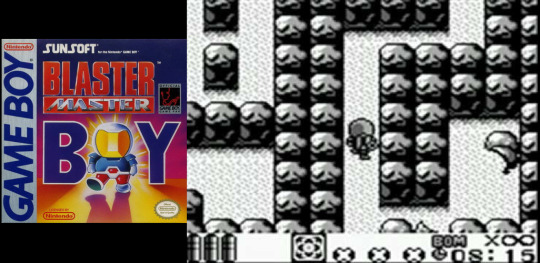
1991 - Blaster Master Boy (Game Boy)
Prior to playing the original, I had no idea there were so many titles in this series. I definitely didn’t know there were multiple portable entries. Blaster Master Boy is less a Blaster Master game and more a Bomberman game. Technically its a sequel to the Bomberman spin-off Robo-Warrior. A quick trip over to Youtube can confirm that the gameplay and music are lifted directly from Robo-Warrior. To add even more confusion, in Japan, Robo-Warrior was called Bomber-King, Blaster Master Boy was Bomber-King Scenario 2 and it wasn’t even published by the same company.
Because of this weirdness, I didn’t spend too much time with Blaster Master Boy. It also didn’t help that there isn’t a decently priced copy anywhere on the internet.
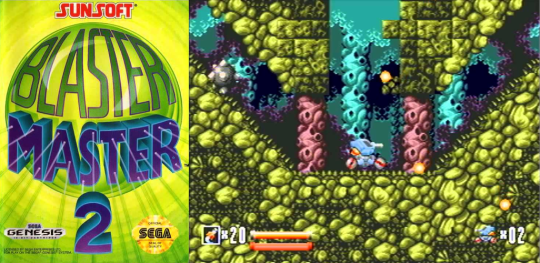
1993 - Blaster Master 2 (Genesis)
Five years after the original, Blaster Master returned to the console market with Blaster Master 2. It was a Sega Genesis exclusive and the only title in the series released in the 16-bit era. Playing this immediately after the original really made it quite hard. The controls aren’t as precise and the difficultly level is somehow ratcheted up. Blaster Master 2 is a more straight forward platformer without the backtracking of a traditional Metroidvania.
Unlike the first game, when you enter the human sections of the game, you don’t start a top-down sequence. Instead, the pilot levels are 2D platform shooter areas. All of these seem half-baked, clunky and compared to the game’s contemporaries, quite sad. Fortunately, top-down gameplay wasn’t completely abandoned, before the end of each level there’s an odd top-down sequence, where you pilot Sophia. This mechanic never returns in future games, but taking the rest of the game into consideration, it really isn’t terrible.
Unfortunately, there’s not much good to say about Blaster Master 2, It hits most of the design notes that the first one hits but the entire experience feels like it was made by a completely different team. Funny enough, after saying that, I looked it up and Blaster Master 2 was, in fact, made by a completely different team. Ha!
The game’s only saving grace is its vivid color pallet and solid sprite design. Like the first game, the music solid, but unless you’re taking a trip through the whole series like me, Blaster Master 2 can be skipped.
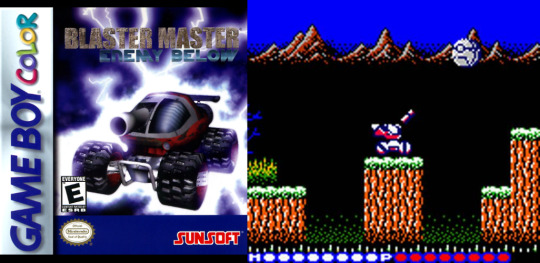
2000 - Blaster Master: Enemy Below (Game Boy Color)
It took Sunsoft awhile to get around to the Blaster Master series again, but in 2000 they came out swinging. Blaster Master: Enemy Below was released for Game Boy Color and of all the games on this list, it is the game that most resembles the original. Much of the art is designed to look nearly identical to the NES games’, even down to a nearly pixel-perfect recreation of the SOPHIA tank.
The top-down Jason segments return as does the extreme difficulty and fantastic soundtrack. It’s hard to really complain about the execution of this title. It was clearly an attempt at just trying to make the closest thing they could to the original and in many ways, it is a tighter and more consistent experience. Unfortunately, that’s also a strike against it. Enemy Below doesn’t bring anything new to the table. The bosses are basic re-hashes of the originals, the levels feel like a “lost levels” DLC pack and the game being portable doesn’t really encourage innovation.
I guess the coolest thing I can say about Enemy Below is that it's still available for purchase. On the 3DS Virtual Console, you can pick up Enemy Below for about $5. At that price, it’s easy to recommend, especially since it comes with built-in save-state functionality.
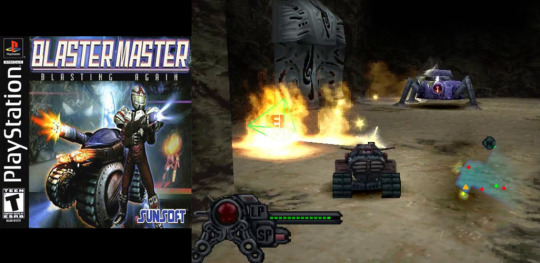
2001 - Blaster Master: Blasting Again (Playstation)
Also, released in 2000 (in Japan, 2001 in North America), is the weirdest game in the series to date, Blaster Master: Blasting Again. For those of you too young to remember, the Playstation/N64 era of video games was full of 2D series trying their hand at 3D games. Blasting Again is an egregious example of this frustrating industry trend. You still pilot a tank, with all the same features, like homing missiles, and hover, but you’re dropped into a fully realized 3D world with painfully bad anime cut-scenes.
The “Jason” sequences are still here, but they too are 3D and mundanely boring. Also, with this being an official sequel to the original, you play as Jason’s son Roddy, not Jason. Much of the music from earlier in the series is remixed, and rerecorded, so not all is lost in the odd one-off. Unfortunately, the antiquated tank controls and punishing difficulty makes Blasting Again hard to recommend. I was able to play it on PS3 with no issues, but the toggle switch for the digital and analog controls was initially hard to find.
I ended up sinking about 40 hours into finally beating this tragedy. I wasn’t able to use save states and despite it being objectively bad, I grew to love it’s janky and unfair presentation. As a whole, these games have really tested my ability to control my anger, but Blasting Again was the first one to truly get all the way under my skin.

2010 - Blaster Master: Overdrive (WiiWare)
Notice, I have yet to say any of these games are good, that’s because they aren’t. What they have is a charm to them that conjures the aura of the scrappy beginnings of gaming and the forced appreciation of only owning 4 games that had no checkpoints. Thus far, despite initial misgivings, I’ve enjoyed my time on this journey. Blaster Master: Overdrive is where that joy ended. The fun I was having with the series was taken out back, brutally beaten, and left to die in the town square as an example to anyone daring to play this absolute nightmare.
Overdrive starts innocently enough. It does it’s best to try and evoke the gameplay and tone of the original and for what it's worth the art style isn’t terrible. The Sophia and Jason gameplay loops are in-tact and even the gun-upgrades are more important than ever. Where Overdrive falls apart is its difficulty and embarrassing lack of control options.
I’m sure most of you are at least familiar with the Wii-Remote. With this being a Wii-Ware only game, it could only be played with the Wii-Remote. The real downside is that the developer either ran out of time or opted not to explore the myriad of control options the Wii offered. There’s no classic controller support, no Gamecube controller support, there’s not even a way to map buttons to a nun-chuck. You are stuck playing with the Wii-Remote turned sideways.
This wouldn’t be that big of a deal if they had found a better way to implement strafing into the controls. To strafe, the player must hold the B button. That’s the button underneath the Wii-Remote. In a world where the player is using the remote like an old-school NES controller, B button usage is a legit finger-bending-nightmare. Couple this broken control scheme with punishing difficulty and you have the perfect recipe for rage-quitting. I‘m not proud of my behavior during my time with this game and let’s just say I own 1 less Wii-Remote now.
The last thing I want to say about Overdrive is less about the game itself and more about its availability. The Wiiware marketplace is 100% closed, which means there’s no legit way to purchase this game, outside of buying someone’s Wii who had already bought it. This is an ominous foreshadowing of things to come. I would have paid for this game. Hell, I’m deep enough into this BM adventure I would have paid a premium to play this dumb game, but Nintendo’s shut-down of the Wii-Ware shop is a low-key attack on game preservation that us archivist, CANNOT forget. *steps off of soap-box*

2017 - Blaster Master Zero (Switch/Steam)
With the release of Blaster Master Zero, the series got the most attention it’s had since the original game. Most of that attention was because Zero was basically a launch game for the Switch. The best way to describe Zero is to say that it’s developer Inti’s attempt to take the Blaster Master formula and actually make a decent game. For the most part, they succeed. Oddly enough, almost 30 years later, Zero is the first legitimately good Blaster Master game.
Much like Enemy Below, Zero tries its hardest to evoke the look of the original NES game. Some refer to games like this as pixel art, others refer to it as lazy...I float somewhere in the middle on it. It was great playing a Blaster Master game with a proper controller where the mechanics actually work. However, it was frustrating seeing a game, based on a design aesthetic that hit its ceiling in the late 80s, try to beautify itself. Many attempts were made to make the design stand out, but it just kept hitting the ceiling established by its predecessors.
Alternately, by Inti making the game super-playable, the flaws of the older games stand out even more than before. Typically, good Metroidvania’s have an intuitive way of hinting at where you need to go next or a good way of telling you what access you’re new power-ups give you. Due to Zero’s obsession with evoking the original, that intuitive gameplay is replaced with a red box on the map screen. This turns the game into a “drive to red box, shoot things, drive to next red box and shoot more things, experience”, rather than the naturally explorative nature of other games in its genre. The anime story seemed unnecessary from the start, but I’m sure someone will enjoy it.
While playing Zero I honestly asked myself, “Is this game way easier than the older games, or can I finally control this little tank properly?” I’m sure the real answer is somewhere between those two extremes, but ultimately Zero was a blast, albeit WAY too easy. I’m really looking forward to seeing how the sequel improves upon this wonderful jumping-off point. However, I’m positive I’ll be disappointed that more wasn’t done to bring the series into the modern 2D-platforming space.

2019 - Blaster Master Zero 2 (Switch)
Zero 2 is very much a sequel to Zero. In true anime fashion, the story immediately gets super self-serious and consequently superfluous. I’m sure some players will love the dialog between protagonist Jason and all of the various anime-faced characters, but that’s not what I’m here for. Needless to say, the story gets involved in ways other Blaster Master games haven’t. That’s not a strike against it, it’s just a characteristic that may not actually matter.
All previous mechanics are intact here and new ones are introduced almost immediately. If Zero was truly the first good Blaster Master game, then the refinements introduced in Zero 2 make it...wait for it...THE BEST BLASTER MASTER GAME EVER MADE! It controls well, the levels are interestingly built, and where previous sequels in the series lacked innovation, Zero 2 is full of cool and weird, new stuff. The bosses are fresh and interesting, the Jason sequences have been enhanced with a brand new counter mechanic and the space travel segments add a level of depth not seen in previous games.
I hate that I’m being so positive about the game. It’s been so much fun talking shit about Blaster Master games. Unlike the previous game, developer Inti found a way to modernize the gameplay and still make a genuinely challenging experience. I had trouble with multiple bosses, but never did I feel like the game was unfair, or something was broken. Many of the additions to the story also benefited the gameplay. Something as simple as making the Frog from the original game the reason Jason can immediately leave dungeons serves both the story and gameplay.
This has been a long journey, and the real hero is Inti Creates. Hopefully, Zero and Zero 2 have done well. The work put in by Inti deserves praise. They have perfected a formula that’s been pending since 1988. Both titles are only $10 on the Switch shop, and at that price, you are basically stealing them. Anyone with a Switch has no reason not to pick at least one of them up and check it out.
As for the series itself...I have very mixed feelings. There are very few good Blaster Master games. It's a series that trades in loose nostalgia for a widely forgotten NES game. From that, a bunch of often half-hearted sequels were developed trying to capitalize on the little bit of cache the original game still has. I don’t regret my time with the series and I think more titles deserve the Blaster Master treatment, but subjectively, I wouldn’t recommend anyone pick up any games outside of the original and the 2 newest Switch titles.
#blaster master#blaster master zero#blaster master enemy below#blaster master blasting again#blaster master overdrive#blaster master 2#blaster master zero 2#blaster master boy
15 notes
·
View notes
Note
wait, you mentioned the timeline from the RPG games, what RPG games that are about wolfenstein, commander keen and doom? :O
There are three, well, four mobile Java games made by id software released the past decade, back when flip phones were the standard. Three of them are based on their franchises DOOM and Wolfenstein, and the last one was fantasy-themed and used the engine of the Wolfenstein/DOOM 2 RPG one. There’s no Commander Keen one, sorry.
Contrary to the PC games, the RPG games are turn-based RPGs, all combat and movement is turn-based and you and your enemies move space by space.
The first one is DOOM RPG and was released in October of 2005, it follows a story where you arrive at a UAC facility in Mars (not located in Phobos or Deimos, but in actual Mars), where you must help them from the attacks of demons. As you progress you will start unveiling what really is happening in the UAC facility, but it’s so funny because the story is so predictable and tongue-in-cheek that there’s no need for you to think that hard about what’s really going on.
There’s also a lot of humor. The DOOM mobile games are probably the funniest entries in the franchise. You get to read various chat logs between UAC scientists where you learn the most ridiculous shit.
The first password for a locked door that you enter in the game is literally 1234 because the guy in charge was too lazy to come up with a good one.
The computer where you type the second password asks you the year when DOOM was released (1993)
You get another password after reading an e-mail and learning that you must open the automap and read the number the map spells (which is 1337)
At one point of the game you must type a super secret pass for a locked room that you can only access in that map, that number being the first 7 digits of the Fibonacci sequence.
You can also control unique weapons such as the Axe (your chainsaw equivalent/replacement) that you can also use to open stuck doors, and even a Fire Extinguisher that can extinguish fires (there are plenty in the game) and can also deal huge amounts of damage to fire-based monster families like the Lost Soul and the Archvile. Oh yes, there are also demon classes: Lesser, Normal and Strong types, basically all of them are recolors of the original sprites.
You also get to fight diabolical dogs (they’re actually sprites borrowed from Wolf3D’s dogs), and you can even tame and carry one of them with a red collar to make him fight for you.
The Wolfenstein one is called Wolfenstein RPG and was released in September 2008. It features a different engine, but the same style of gameplay. Think of it as a mixture of the post-2000s Wolfenstein games and Wolfenstein 3-D. You don’t get to fight Hitler in this one, but you get to fight a literal demon from Hell called “Harbinger of Doom” (I know, keep reading) that was summoned by the Nazis. This is of huge importance for what’s coming next.
Blazkowicz fights the Harbinger while using the mythical Spear of Destiny (so far the only Wolfenstein game where you actually get to use it), and badly injures the Harbinger by butchering a leg and an arm and maiming its stomach. The demon escapes back to Hell not before swearing to fight a descendant of B.J. in the future.
The second DOOM game is DOOM 2 RPG and was released around the same time as the Wolfenstein one while using the same engine.
The story is that a spaceship arrives at a UAC facility in space in order to attend an emergency, loaded with three people: a scientist, a Major (a woman) and a Sargeant, that sargeant being Doomguy - Stan Blazkowicz, which is of course a long, distant descendant of B.J. Blazkowicz. You can choose from those three but the “canon” option is of course Doomguy.
You get to fight a lot of different and very unique demons, one of them is an Imp variant with a chainsaw, another one is a slug that spits pinkies and is called the Pinkynator, and the final boss is a demonic AI called VIOS (which stands for Virtual Icon Of Sin). And in case you’re wondering, yes, you do get to fight a Cyberdemon that is arguably the very same demon that B.J. Blazkowicz fought many centuries ago.
The humor is not absent from this game, too. There’s a weapon called the Holy Water Pistol that works exactly like the Fire Extinguisher from the first mobile game, and it can deal huge damage to fire based enemies (Lost Souls and Archviles) and can stun and scare most of the demons. Since it’s water-based, you need to refill it every now and then, and the only source of water in the UAC bases are basins and toilets. There’s also treadmills that you can use, and you can actually die by going too fast and falling from them.
These games are pretty fun and are excellent time-killers. Unfortunately like I mentioned before, these are Java-based, and you can only play them in a decent manner on phones that can run Java games. Not to mention that none of these games are being sold anymore, so your only option if you really want to try them is to download them from the internet.
I don’t know a single person who has played the mobile RPG games and doesn’t want them to be adapted for the PC version. Needless to say, I'm also a huuuuge fan of the first DOOM RPG.
There have been small inclusions of some of the elements and weapons from the mobile games in various mods such as MetaDoom made by @kinsie (if I recall correctly, he included the Holy Water Pistol, the Fire Extinguisher, the Axe and the Sawcubus).
Do I recommend playing them? Absolutely. But like I said, the only way to play them is not that ethical, but if you don't mind that part, feel free to give them a try!
#letsrevince#ask#gaming#DOOM#doom rpg#doom 2 rpg#videogames#video games#mobile games#mobile gaming#J2ME#java games#long post
116 notes
·
View notes
Text
Megami Tensei Gaiden: Last Bible
A.K.A. Revelations: The Demon Slayer
(Part 4 on a series of posts covering as many games in the MegaTen franchise as I can actually play)
Having successfully established a new canon with Shin Megami Tensei, things were going along smoothly, and the soil for new MegaTen titles was as fertile as it had ever been. However, SMT's ending was, in many ways, terminal for a lot of what was established therein. The situation of things kept changing drastically through the entire game and, by the end, things were pretty catastrophic. It would be a little while before they though up of some good material to serve as a base for SMT II, and, in the meantime, to keep fresh products coming out (and probably to keep the money coming in), Atlus chose to develop a spin-off series.
Last Bible was released for the Game Boy the same year as SMT, and recontextualized the core distinctions of the series into something more like what you'd expect from a jRPG in 1992. Gone are the first person dungeons, and instead we have a normal tile-based top-down RPG with DQ-esque character sprites walking around. Gone is the moral axis and branching story, and now things are as linear as they could, with only one path leading to one conclusion. Features like the demon summoning and recruitment have been majorly simplified, and in general, the game plays a lot more traditionally than anything the series has outed so far. There's no guns and no phases of the moon. That's not to say it doesn't still have its own quirks, but it's interesting to observe the transition from SNES to GB and all the compression and simplification that entails.
Furthermore, the setting was also moved to a more traditional, medieval fantasy-ish place, and demons aren't really demons anymore, just nondescript monsters with an in-game origin. You can still summon them, but it's done through a vague "sort" menu instead of the COMP for obvious reasons. You can also still talk to them, but they don't have any particular race or alignment to dictate their rough personality, so the questions are more or less random (there seems to be a repeatable pattern, but the actual text makes no logical sense in terms of a conversation) and whether or not you'll recruit them at the end of the conversation is effectively a crapshoot.
All of this obviously makes Last Bible miss a lot of what makes the series unique, and if you didn't know it was part of the MegaTen brand, you'd probably just take it for a generic RPG adventure clogging up the GB's library and pick up Final Fantasy Legend 2 instead. Honestly, if you did, you probably wouldn't be missing much, anyway.
It's not that the game is bad, per se. It has a decent, harmless little plot; some of the recontextualizations (such as the series' iconic powerful demons having been reworked into what are essentially powerful mage dudes) are funny; the aesthetics have an odd classical age vibe to them which is kind of interesting, with a lot of greek and egyptian inspirations; the music is above average for an early GB game (and the final boss in my opinion has a really kickass theme with one of the finest basslines the system can throw at you); and series traditions regarding demon handling have been simplified, but still function in roughly the same way, allowing you to experience the insane level of customization MegaTen usually offers, just in a different kind of place.
But, for a series that evolved its experimentation with storytelling into the character-based, uniquely moral narrative offered by SMT, with so much room for growth and potential to extrapolate and expand on previously established themes, Last Bible feels like a big step down. You can tell, while playing, that it was a much easier game to make than SMT, not only in terms of technical stuff, but also as far as challenging the developers' creativity goes. Consequently, this is mirrored in the fact that the game doesn't really have any poignancy of its own. I understand that the fact it was made for the Game Boy, a system designed for kids to just pick up some more simplistic, breezy adventures and enjoy them on their way to school and etc. means that Last Bible does its job nicely and there's really no point in me trying to compare it to mainline SMT since it's not trying to be SMT, so it isn't like I get angry with the game or chastise the developers and think they're slacking sacks of crap or whatever. But hey, still, if I'm looking at the game analytically, it has to be said it doesn't bring much new to the table.
One thing it does have over SMT 1, technically, is that there can be two enemy groups per battle now. There WERE a few scripted encounters in SMT 1 against two groups of enemies, but now, they can happen in any run-of-the-mill random encounter (unless the enemy sprite is too big), so that's nice. Also, the protagonist can use magic, which is a bit surreal in MegaTen terms. Furthermore, anyone can talk to monsters, even other monsters, and that means you won't have to go through the tedious generic yes/no conversations, so that's a good option to expedite the process, though I believe you need to select the right monster for the job or something, I have no idea. It'd be cool to see demons interacting with each other in mainline SMT games...
I think this is where I start to realize I may be a bit of a subconscious contrarian in some aspects, but despite the rest of the internet saying otherwise, I found this game to be really hard. Enemies were constantly able to kick my ass with two or three hits, it never felt like I had built my characters correctly and it always felt like I was at risk. A little ways into the game, I discovered, through the fact a monster attacked one of my own monsters of the same kind as them, that enemies actually get a significant boost in the damage they deal to you, which is Last Bible's iteration of old game design bullshit. Luckily, dungeons are really short throughout the entirety of the game, and you can save anywhere you want (except in-battle), even in the dungeons themselves right in front of the boss's face (because you wouldn't want to lose your progress when the school bus arrives and you're forced to put the Game Boy away, you know), so I guess when it all comes down to it, it was "easy", but damn. I'm not sure if I get bothered by the fact the dungeons are so short and have nothing to separate themselves from each other or if I'm glad they are like that because it meant my sorry ass could actually clear them. Maybe the high damage and stuff was once again done like that to be congruent with the portable nature of the system, so even battles needed to go by quickly one way or the other, but I don't know.
Anyway, Last Bible is not a very interesting game, but it did manage to entertain me somewhat, and the difficulty meant that there was at least something stimulating happening most of the time. It had a very Dragon Quest 2 vibe to it, and I think that's not exactly a bad thing (I only wish there were more puzzles and interactions with rhe world to make overworld exploration as interesting as it was in DQ2). I believe it deserves a 5 out of 10, smack-dab in the middle of the scale just like any game where my main conclusion is that nothing was really gained from playing it, but nothing was lost either. And hey, now that they got that out of their system, the developers can jump right back on track and start work on another actually intellectually charged, passionate project, right?
1 note
·
View note